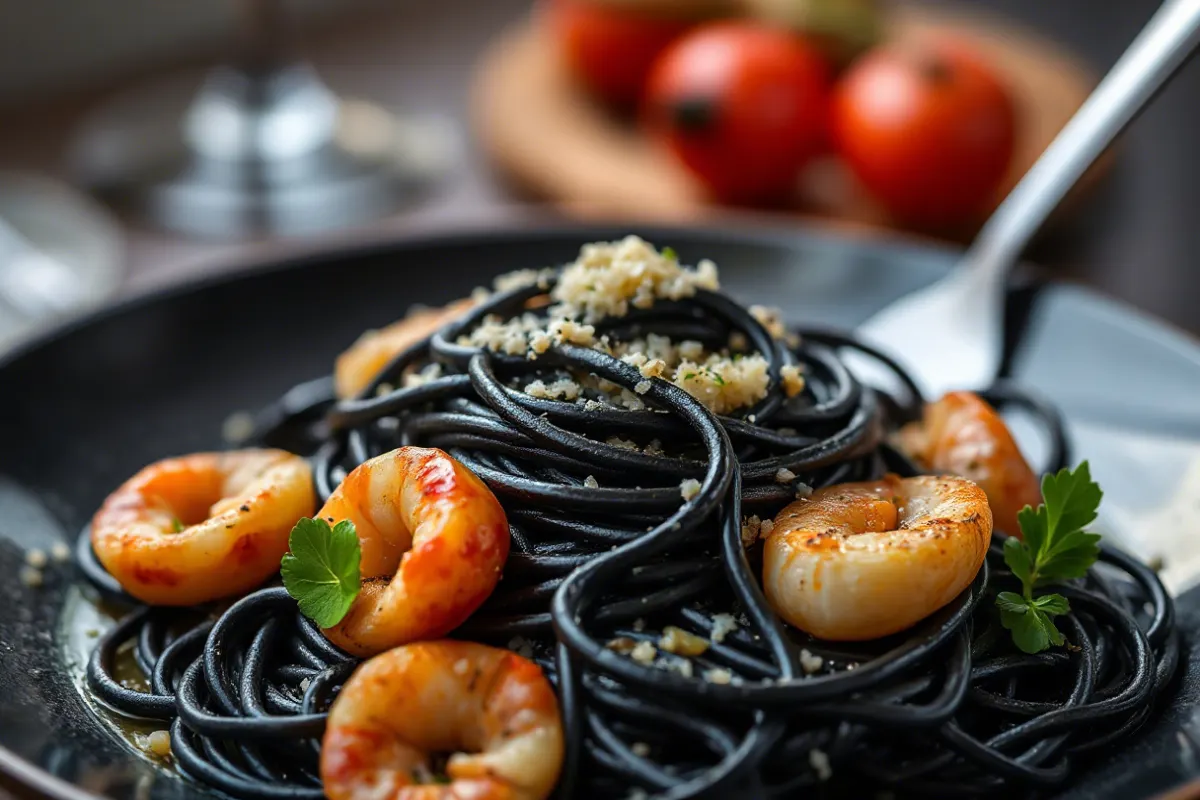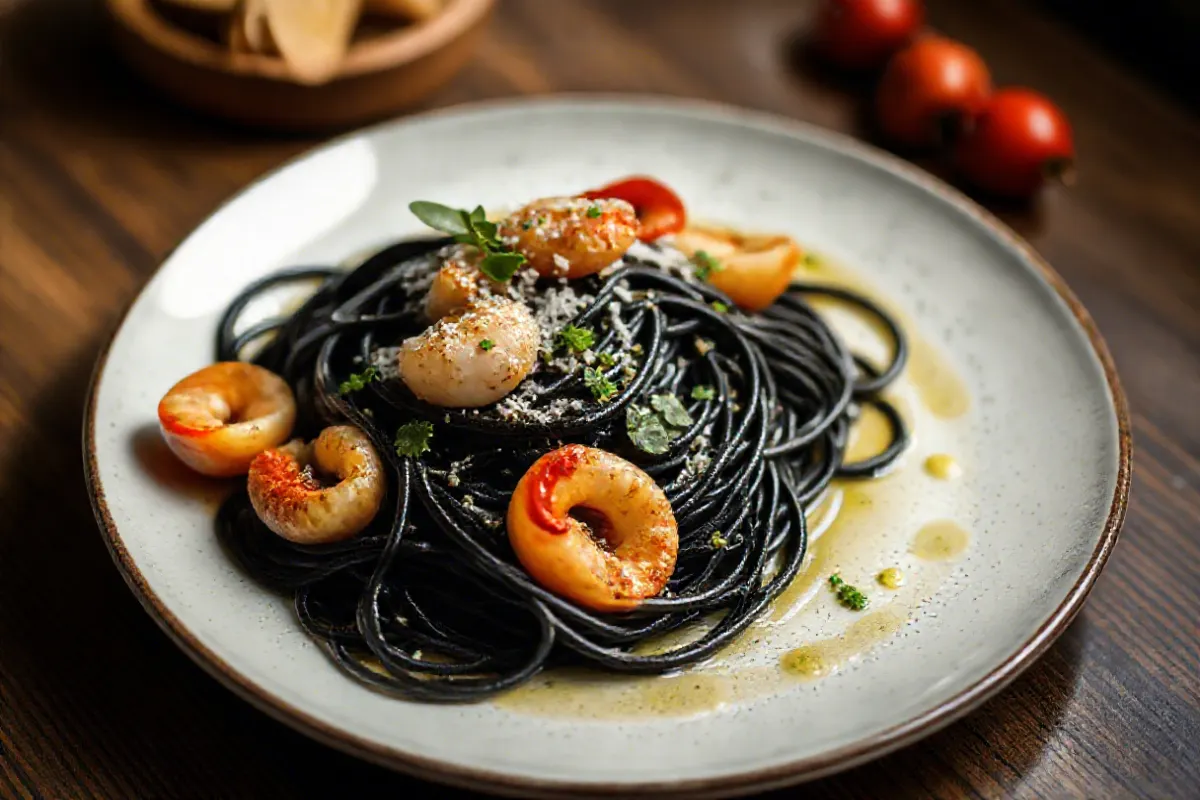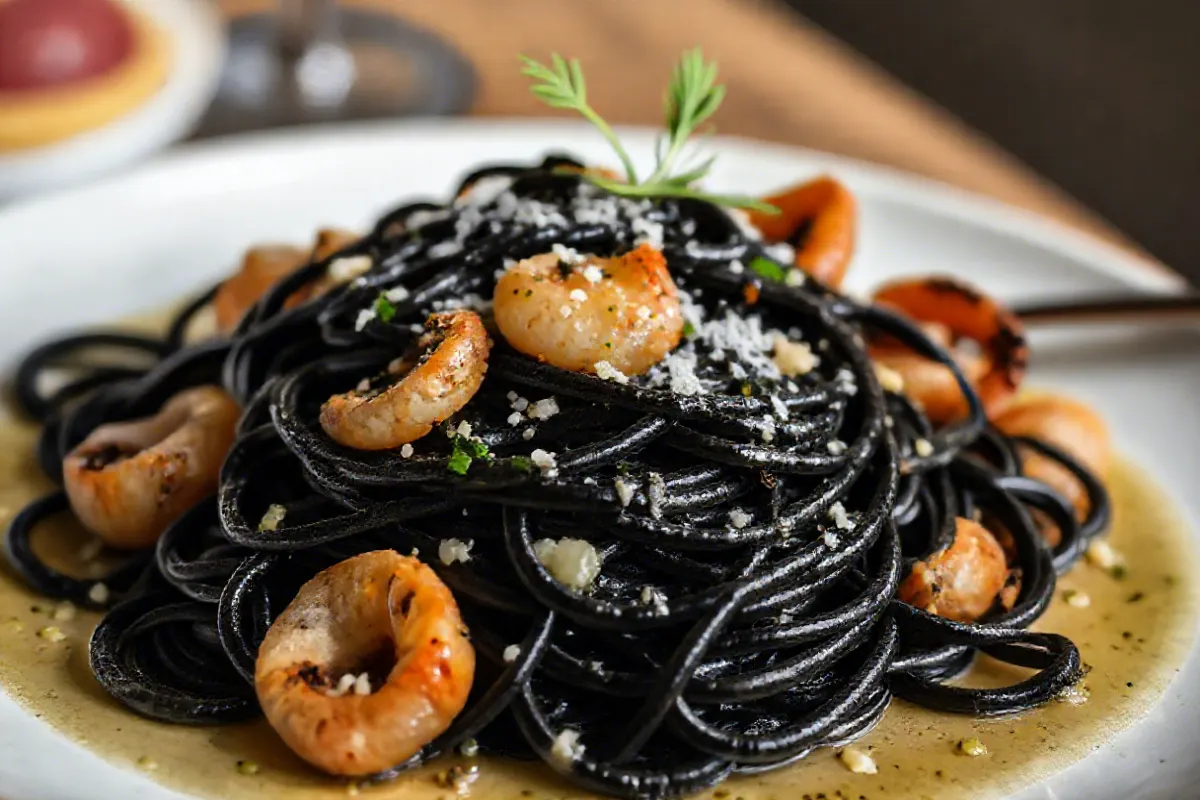Introduction
Black spaghetti is a type of pasta that catches the eye with its striking dark color. Unlike regular pasta, which is made from wheat and water, black spaghetti gets its unique color from squid ink. This might make you wonder if it tastes different from the regular pasta you’re used to. Does the black color change its flavor, or is it just a visual difference? Let’s explore what makes black spaghetti special and whether it actually tastes different.
Black spaghetti, also known as squid ink pasta, is popular in Mediterranean and coastal Italian cuisine. The squid ink gives the pasta its bold black color and a distinct flavor that sets it apart from other types of pasta.
Squid ink isn’t just a dye; it has its own special taste. It adds a mild salty flavor that reminds people of the sea. If you’ve never tried black spaghetti before, it might seem strange, but it’s actually a unique and delicious experience that has been enjoyed for generations, especially in Italy.
The Origin of Black Spaghetti
Black spaghetti has a long history in Italian cuisine, especially in coastal regions like Sicily. In these areas, seafood plays a major role in the local diet, and squid ink has been used for centuries to add both flavor and color to dishes. Traditionally, black spaghetti was made fresh, by hand, and used in dishes that often featured other seafood ingredients.
Squid ink pasta, or spaghetti al nero di seppia, is commonly served with seafood like shrimp, clams, and squid. These ingredients complement the briny, slightly salty taste of the squid ink. Over time, this type of pasta spread beyond Italy and is now available in many parts of the world. Today, you can find black spaghetti at Italian restaurants, specialty food stores, and even some supermarkets.
While black spaghetti may look exotic, it’s still made from the same basic ingredients as regular pasta. The only difference is the addition of squid ink, which provides the black color and a mild, salty taste. The unique appearance and flavor make black spaghetti a favorite choice for gourmet dishes and fancy meals.
What Gives Black Spaghetti Its Color?
The deep black color of black spaghetti comes from squid ink, which is added during the pasta-making process. Squid ink is a natural ingredient harvested from squids, and sometimes cuttlefish. It is used to give the pasta its bold, dark color and also to add a hint of salty flavor.
Unlike artificial food coloring, squid ink is all-natural. The black color it gives to the pasta is intense, but it doesn’t affect the pasta’s texture. In fact, some people say that the squid ink adds a silky feel to the pasta, making it a little richer and smoother than regular pasta.
Fun fact: The color of squid ink is so intense that even a small amount can turn an entire batch of pasta black. Just a teaspoon of squid ink is enough to dye a large portion of spaghetti.
Squid ink isn’t just used in pasta. It can also be found in risotto, bread, and even sauces. In each dish, the ink adds that same dark color and a subtle, savory flavor that makes it unique.
External link: Learn more about squid ink’s flavor in this Food Republic article.
Does Black Spaghetti Taste Different from Regular Pasta?
Now, onto the big question: Does black spaghetti actually taste different from regular pasta? The answer is yes, but the difference is not as big as you might think. Here’s what you can expect when you try black spaghetti:
- Mildly salty: Squid ink adds a mild salty flavor to the pasta. This saltiness is different from the salty taste of added table salt. It’s more like the taste of the ocean—a briny, natural saltiness that’s often compared to seawater.
- Umami taste: Black spaghetti has a rich, savory flavor thanks to the squid ink. This taste is often described as umami, which is one of the five basic tastes, alongside sweet, sour, bitter, and salty. Umami is a Japanese word that means pleasantly savory, and it describes the deep, rich flavor you get from squid ink.
- Not fishy: While some people expect black spaghetti to taste like fish because it’s made with squid ink, the truth is that it’s not very fishy at all. The flavor is more like seawater than seafood. It’s briny but subtle, and the taste of the squid ink is often masked by whatever sauce or ingredients you pair with the pasta.
Regular pasta, on the other hand, is usually bland on its own. It doesn’t have much flavor until you add a sauce or seasoning. Black spaghetti, however, brings its own subtle flavor to the table. This makes it a bit more interesting, especially when paired with light sauces that allow the squid ink flavor to shine through.
Factors That Affect the Taste of Black Spaghetti
While black spaghetti has a unique flavor, its taste can change based on a few factors. Here’s what you should know:
- Quality of squid ink: The quality of the squid ink used can have a big impact on the flavor of the pasta. High-quality squid ink will give the pasta a richer, more complex taste, while lower-quality ink may result in a bland flavor. If you’re making black spaghetti at home, it’s worth investing in high-quality squid ink to get the best flavor.
- Fresh vs. dried black spaghetti: Like regular pasta, black spaghetti comes in both fresh and dried forms. Fresh black spaghetti is often softer and has a more intense flavor, while dried black spaghetti is firmer and has a milder taste. Fresh black spaghetti is usually found in specialty stores or made by hand, while dried black spaghetti can be purchased in most grocery stores.
- What it’s served with: The sauce and ingredients you pair with black spaghetti can also affect its taste. Black spaghetti pairs well with seafood, olive oil, garlic, and light tomato sauces. These ingredients enhance the natural briny flavor of the squid ink without overpowering it. On the other hand, heavy cream or cheese-based sauces might mask the flavor of the squid ink, making the black spaghetti taste more like regular pasta.
Popular Recipes Using Black Spaghetti
If you’re curious about trying black spaghetti, here are a few popular recipes that showcase its unique flavor. Each recipe highlights the subtle, salty taste of squid ink and pairs it with complementary ingredients.
| Recipe Name | Main Ingredients | Flavor Profile |
|---|---|---|
| Squid Ink Spaghetti with Seafood | Black spaghetti, shrimp, squid, olive oil | Briny, rich, with a hint of seafood flavor |
| Black Spaghetti with Garlic & Oil | Black spaghetti, garlic, olive oil, chili | Mild, slightly spicy, and savory |
| Fusion Black Spaghetti | Black spaghetti, cream sauce, vegetables | Creamy with a mix of umami and sweetness |
Black spaghetti works best with light, flavorful sauces that let the squid ink shine. Here are a few tips for making the perfect black spaghetti dish:
- Seafood is your friend: Black spaghetti pairs beautifully with seafood like shrimp, squid, clams, and mussels. The natural saltiness of the seafood complements the squid ink’s briny flavor.
- Keep it simple: The flavor of black spaghetti is delicate, so don’t overdo it with heavy sauces or too many ingredients. A light garlic and olive oil sauce, or a simple seafood broth, is usually the best way to go.
- Play with color: The dark color of black spaghetti makes it a great base for colorful ingredients. Add bright red tomatoes, green herbs, or white seafood to make the dish visually appealing.

Nutritional Profile of Black Spaghetti
From a nutritional standpoint, black spaghetti is quite similar to regular pasta. It’s made from the same base ingredients—wheat and water—so the calorie, protein, and carbohydrate content are very much alike. However, the addition of squid ink adds a few extra nutrients that you won’t find in regular pasta.
Here’s what you can expect from the nutritional profile of black spaghetti:
- Calories: Black spaghetti has the same calorie count as regular pasta. A typical serving of pasta contains around 200–220 calories, depending on the brand and type.
- Proteins and Carbs: The protein and carbohydrate content of black spaghetti is also similar to regular pasta. Most of the nutritional value comes from the wheat used to make the pasta.
- Squid Ink Benefits: Squid ink is rich in antioxidants, which help protect the body from damage caused by harmful molecules called free radicals. Iron is another ingredient that it includes, and iron is necessary to keep red blood cells healthy. However, the amount of squid ink in black spaghetti is relatively small, so these nutritional benefits are limited.
FAQs
You might have some questions about black spaghetti, especially if you’ve never tried it before. Here are the answers to some common questions:
Does black spaghetti have a stronger taste than regular pasta?
Yes, black spaghetti does have a stronger taste than regular pasta, but the difference is subtle. The squid ink adds a mild, salty flavor, but it’s not overpowering.
Is black spaghetti safe for people with seafood allergies?
No, black spaghetti is not safe for people with seafood allergies because it contains squid ink. If you have a seafood allergy, it’s best to avoid black spaghetti and other dishes that contain squid ink.
Why is black spaghetti more expensive?
Black spaghetti tends to be more expensive than regular pasta because squid ink is a specialty ingredient. It’s more costly to harvest and process, which drives up the price of the final product.
How should black spaghetti be cooked?
Black spaghetti should be cooked just like regular pasta. Heat up a big saucepan of water until it boils, add salt, and cook the pasta for 8–10 minutes or until al dente. Be careful not to overcook it, as black spaghetti can become mushy if left in the water for too long.
What sauces pair best with black spaghetti?
Light, flavorful sauces like olive oil and garlic, tomato-based sauces, and seafood sauces pair best with black spaghetti. These sauces complement the squid ink’s briny flavor without overpowering it.
Where can you buy black spaghetti?
Black spaghetti is available at specialty food stores, gourmet grocery stores, and online. It’s less common than regular pasta, so you might need to search a little harder to find it.
Is black spaghetti vegan-friendly?
No, black spaghetti is not vegan because it contains squid ink, which is a product of animal origin.
How to Cook and Serve Black Spaghetti
Cooking black spaghetti is simple and follows the same instructions as cooking regular pasta:
- Bring a large saucepan of water to a boil.
- To enhance the flavor of the pasta, add salt to the water.
- When the black spaghetti is al dente, add it and simmer for 8 to 10 minutes.
- Drain the pasta, but save a little bit of the cooking water. This can help make your sauce thicker if needed.
- Toss the pasta with your favorite sauce, such as olive oil, garlic, and chili flakes, or a seafood sauce.
Here are a few tips to make sure your black spaghetti turns out perfectly:
- Don’t overcook it: Black spaghetti cooks quickly, so keep an eye on it. Pasta that has been overcooked may become mushy and less tasty.
- Save the cooking water: The starchy water left over from cooking black spaghetti can be used to thicken sauces and add extra flavor.
- Serve immediately: Like most pasta, black spaghetti is best served right after it’s cooked. If you let it sit for too long, it can lose some of its texture and flavor.

Conclusion
Black spaghetti isn’t just a visual novelty; it’s a pasta with a unique taste and history. The mild, briny flavor of the squid ink adds a subtle richness to the pasta that sets it apart from regular spaghetti. Whether you pair it with seafood, olive oil, or a simple tomato sauce, black spaghetti brings something special to the table.
If you’ve never tried black spaghetti before, now’s the time to give it a shot. It’s a fun, flavorful, and visually striking dish that’s sure to impress at any dinner party. With its deep color and rich taste, black spaghetti is a pasta like no other.





